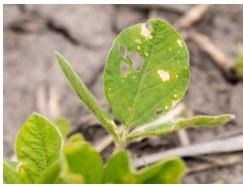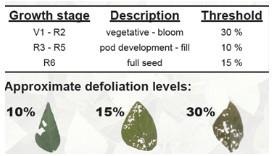By Andy Michel and Kelley Tilmon
Almost every field season has its particular insect problems and surprising‘ gotcha’ moments (we’re looking at you, fall armyworm). But there is a seasonality to our common insect pests in agriculture, and this article outlines a few of the things to look out for in the remaining months of summer. We will continue to monitor Ohio insect problems and provide more in-depth updates as needed.

Bean leaf beetle foliage damage

Growth stage and defoliation
July
- Soybean defoliators of various types (caterpillars, Japanese beetles, etc.) often make their first appearances in July. Thresholds for defoliation in soybean have recently been revised to take into account modern crop values and input costs. Soybeans can tolerate a surprising amount of defoliation and still compensate for a good yield, so don’t pull the trigger too soon. When deciding when to spray, make your decision based on the average condition across the whole field. Many soybean defoliators are concentrated on the edge and spraying the whole field will not provide an economic return.
- Potato leafhoppers are a potential threat to alfalfa from July through September. See our article from last week on scouting specifics.
- July is Western bean cutworm month in corn, but this pest varies widely from year to year. Check our weekly monitoring network for WBC and other moths/caterpillar pests, reported in the CORN newsletter each week. The flight usually begins in mid-June, but peak flight usually occurs in Mid-July.
- Stink bugs in soybean make their first appearances as pods begin to form. From R3 onward, keep an eye on them. This is another edge pest, and swelling populations can benefit from an edge application when needed.
August
- Keep watching those potato leafhoppers in alfalfa.
- Defoliators and stink bugs in soybean tend to ramp up in August so keep these on your radar screen.
- Spider mites can strike many different crops during periods of sustained hot a dry weather, which can happen at any time of year but happens most commonly in August. There are several newer miticides on the market which are very effective when used timely.
- Remember soybean aphids? They are still a pest, but not as significant as before. If your field is infested, now is the time when they can cause damage.
September
- If you have late-planted soybeans that are still green in September when other beans are maturing, they will be a magnet for both stink bugs and bean leaf beetles. Bean leaf beetles feeding on foliage are seldom a problem earlier in the season. But pod feeding on late-season beans holds more damage potential, through direct damage to the seed and also through the introduction of disease.
- When planting winter wheat, be mindful of the fly-free date for your county. Planting after this date can help minimize damage from Hessian fly and also feeding by aphids which can transmit disease, especially barley yellow dwarf virus
Source : osu.edu